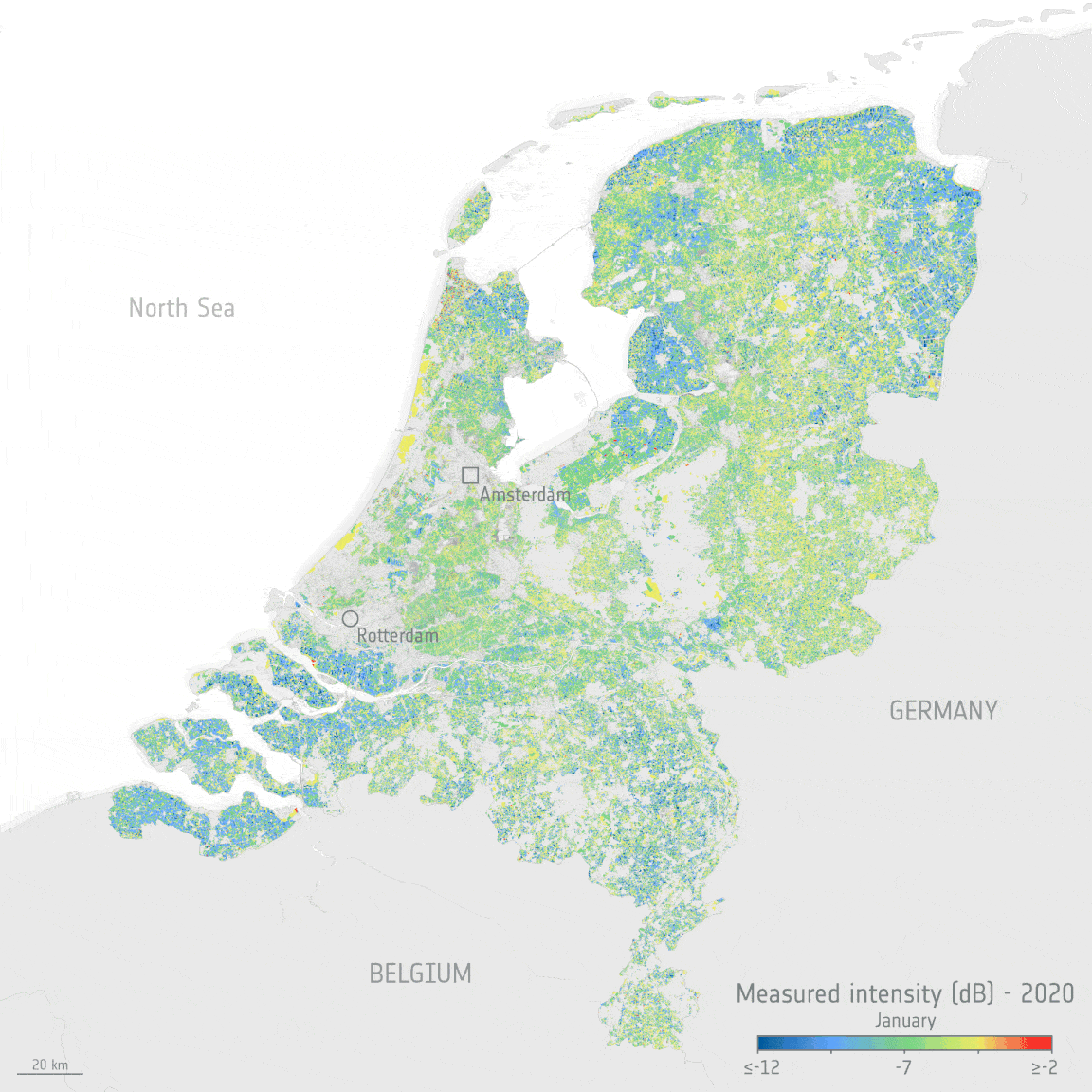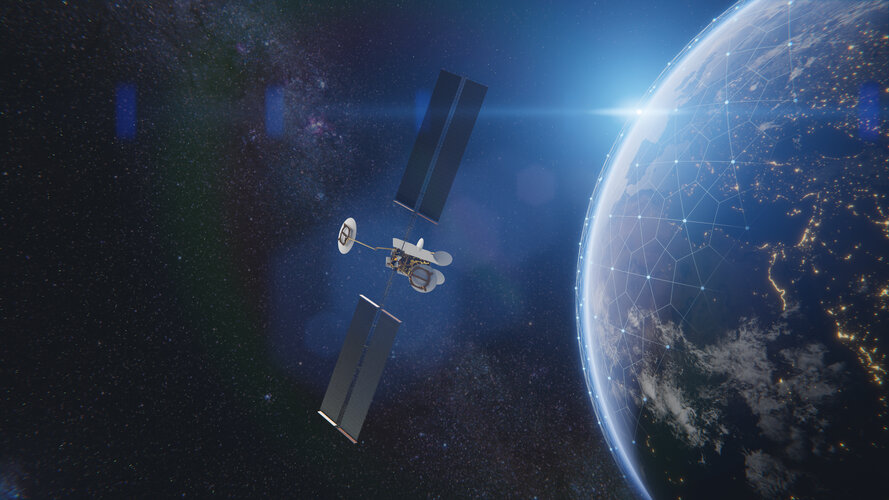
Copernical Team
Monitoring crop health across the Netherlands

The Copernicus Sentinel satellite missions measure and image our planet in different ways to return a wealth of complementary information so that we can understand and track how our world is changing, and how to better manage our environment and resources. Thanks to the benefits of different types of data from two particular Copernicus Sentinel missions and an ingenious new dataset tool, people working in the agriculture sector, but who are not satellite data experts, can monitor the health and development of crops, right down to each crop in individual fields.
ESA seeks software ideas to bring smart satellites to life

If we were to talk about our bodies in the technical terms that we typically use to talk about spacecraft, our bones, muscles and ligaments would be our 'hardware', our brain the 'central processing unit (CPU)', and our nervous system the 'software'.
Tonga eruption sent ripples through Earth's ionosphere
 The powerful underwater volcanic eruption that blanketed the island nation of Tonga with ash and sent tsunami waves across the world also caused ripples in Earth's ionosphere, according to measurements from the Global Differential Global Positioning System (GDGPS) managed by NASA's Jet Propulsion Laboratory in Southern California.
When the Hunga Tonga-Hunga Ha'apai volcano erupted on Jan.
The powerful underwater volcanic eruption that blanketed the island nation of Tonga with ash and sent tsunami waves across the world also caused ripples in Earth's ionosphere, according to measurements from the Global Differential Global Positioning System (GDGPS) managed by NASA's Jet Propulsion Laboratory in Southern California.
When the Hunga Tonga-Hunga Ha'apai volcano erupted on Jan. Collaborative research project on quantum technology starts on the International Space Station
 In early December 2021, the project "Development of a laser system for experiments with Bose-Einstein condensates on the International Space Station within the BECCAL payload (BECCAL-II)" commenced, with the involvement of a team of researchers led by Professor Patrick Windpassinger and Dr. Andre Wenzlawski from Johannes Gutenberg University Mainz (JGU).
In collaboration with Humboldt-Univ
In early December 2021, the project "Development of a laser system for experiments with Bose-Einstein condensates on the International Space Station within the BECCAL payload (BECCAL-II)" commenced, with the involvement of a team of researchers led by Professor Patrick Windpassinger and Dr. Andre Wenzlawski from Johannes Gutenberg University Mainz (JGU).
In collaboration with Humboldt-Univ Scientists develop exceptional surface to explore exotic physics
 By demonstrating exceptional control of an open optical system, an international research team has provided a path to experimentally measure and test exotic phenomena and gain insights into new physics with exquisite sensitivity.
Reported in Nature Communications, the Penn State, Michigan Technological University and Vienna University of Technology researchers created a stable surface of '
By demonstrating exceptional control of an open optical system, an international research team has provided a path to experimentally measure and test exotic phenomena and gain insights into new physics with exquisite sensitivity.
Reported in Nature Communications, the Penn State, Michigan Technological University and Vienna University of Technology researchers created a stable surface of ' Researchers set record by preserving quantum states for more than 5 seconds
Protons are probably actually smaller than long thought
 A few years ago, a novel measurement technique showed that protons are probably smaller than had been assumed since the 1990s. The discrepancy surprised the scientific community; some researchers even believed that the Standard Model of particle physics would have to be changed.
Physicists at the University of Bonn and the Technical University of Darmstadt have now developed a method that
A few years ago, a novel measurement technique showed that protons are probably smaller than had been assumed since the 1990s. The discrepancy surprised the scientific community; some researchers even believed that the Standard Model of particle physics would have to be changed.
Physicists at the University of Bonn and the Technical University of Darmstadt have now developed a method that Arianespace to serve OneWeb's ambitions, will orbit 34 additional satellites with Soyuz
 After the successful launch of NASA's Webb Space Telescope on December 25 with Ariane 5, Arianespace is back to the Guiana Space Center (CSG) with Soyuz for a February 10 lift-off. The first Arianespace mission of the year will orbit 34 additional OneWeb satellites. With this mission, Arianespace will exceed 100 satellites launched on Soyuz from the CSG, while OneWeb's fleet will be brought to 4
After the successful launch of NASA's Webb Space Telescope on December 25 with Ariane 5, Arianespace is back to the Guiana Space Center (CSG) with Soyuz for a February 10 lift-off. The first Arianespace mission of the year will orbit 34 additional OneWeb satellites. With this mission, Arianespace will exceed 100 satellites launched on Soyuz from the CSG, while OneWeb's fleet will be brought to 4 UCF lands DOD award for advance hypersonic propulsion research
 Anew race to harness hypersonic speed for travel and defense has started, and University of Central Florida researchers are helping the U.S. stay ahead of the pack with a new $1.5 million U.S. Department of Defense award to develop high-performance fuels for hypersonic propulsion.
The race, which includes competition from Russia and China, recently intensified when it was reported that Chi
Anew race to harness hypersonic speed for travel and defense has started, and University of Central Florida researchers are helping the U.S. stay ahead of the pack with a new $1.5 million U.S. Department of Defense award to develop high-performance fuels for hypersonic propulsion.
The race, which includes competition from Russia and China, recently intensified when it was reported that Chi Search is on for young space entrepreneurs ahead of first UK rocket launches
 With Britain's first satellite launches set to take place this year, the SatelLife Competition is looking for the best new ideas for how to use data collected from space to benefit daily life, from supporting local communities and the NHS, to monitoring the environment and tackling climate change.
The competition is now in its fifth year, with previous winning ideas including drones carryi
With Britain's first satellite launches set to take place this year, the SatelLife Competition is looking for the best new ideas for how to use data collected from space to benefit daily life, from supporting local communities and the NHS, to monitoring the environment and tackling climate change.
The competition is now in its fifth year, with previous winning ideas including drones carryi 